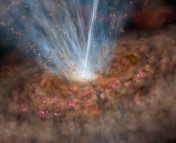Authors: Igor V. Chilingarian, Ivan Yu. Katkov, Ivan Yu. Zolotukhin, Kirill A. Grishin, Yuri Beletsky, Konstantina Boutsia, & David J. Osip
First Author’s Institution: Smithsonian Astrophysical Observatory and Sternberg Astronomical Institute
Status: Submitted to The Astrophysical Journal; open access on Arxiv
Most, if not all, galaxies contain a super-massive black hole (SMBH) at their center. But where did these giants come from? Astronomers know that less massive black holes can form when a star collapses in on itself. These stellar-mass black holes can have the mass of a few dozen suns, but they do not come close to the millions or billions of solar masses a SMBH has.
There are a few ideas for where SMBHs may have come from. One scenario is that the earliest stars left behind small baby black holes, which over time merged together to form more and more massive grown-up black holes which now reside at the center of galaxies. If this were the case, we’d expect to see some teenage, intermediate mass black holes (IMBH) — black holes larger than those born from stars but smaller than those we see in the center of galaxies.
Another possibility is that large gas clouds in the early universe collapsed to form massive black hole “seeds” the size of hundreds of thousands of stellar masses. We then wouldn’t expect to see an adolescent phase of intermediate mass black holes, as SMBHs would start growing from these large seeds instead of small ones left behind by stars.
The authors of today’s paper wanted to see if they could find IMBHs, and thus evidence for the first scenario for SMBH formation.
Finding AGNsty Adolescents
While previous searches for IMBHs looked at only a few, pre-selected galaxies, Chilingarian et al. set up an automated search through 1 million catalogued galaxies to look for signs of black holes that were actively gaining mass — known as an Active Galactic Nuclei (AGN). AGN show distinct spectral lines, as seen in the bottom left of Figure 1. The authors used the width and strength of some of these lines to calculate the mass of the black hole for each galaxy.

Fig 1: The top row shows the breakdown of an Active Galactic Nuclei (AGN). The black hole at the center (far right) has an accretion disk emitting light, while the clouds in the broad and narrow line regions (center) absorb and reemit the light, causing the peaks seen in the spectra at the lower left. The lower right plots show the curves used to fit the emission lines. (Figure 1 in the paper)
Of the million objects analyzed, 305 had black holes with masses less than that of 200,000 suns.
Chilingarian et al. selected 12 of these for follow-up observations. Two of these were not detected in x-ray observations which imply that they are not AGN, leaving the authors with ten bona fide AGN with black hole masses between 43,000 and 202,000 solar masses, five of which were previously known. Images of the ten galaxies which host the IMBHs are shown in Figure 2.

Fig 2: Optical images from the Sloan Digital Sky Survey of the ten IMBH host galaxies. The white line shows the scale; five kiloparsecs (kpc) is approximately ten to the seventeenth power kilometers. The red circle is the location of their observations in x-ray wavelengths. The number at the top is their catalogue designation and the number at the bottom is their mass estimate in solar mass units. The bottom row contains the galaxies with IMBHs found in previous studies. (Figure 2 in the paper)
Results
This is promising for the scenario where super-massive black holes are grown from stellar mass seeds. If SMBHs grew from seeds larger than these observed intermediate mass black holes, then we would not expect to see any IMBHs.
From their original sample of 305 possible IMBH host galaxies, there was enough evidence to confirm or disprove the existence of an IMBH. Only six of those fourteen (or 43 percent) pass all the tests to confirm they host an IMBH. Thus, the authors estimate a lower limit of 131 galaxies will have real IMBHs when further follow-up observations are performed.
The 305 possible IMBHs the authors explore in this paper are only those that are actively collecting more material. There may be many more non-accreting IMBHs out there that cannot be detected because they are too far away for our current instruments.
The accretion of matter from a host galaxy is not enough to explain the growth of stellar mass black holes to IMBHs, so they must come from mergers of smaller black holes. The authors conclude that at least some of the super-massive black holes we observe must come from mergers of smaller black holes.




